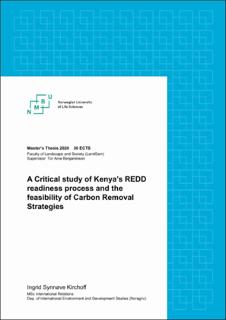| dc.contributor.advisor | Benjaminsen, Tor Arve | |
| dc.contributor.advisor | Cavanagh, Connor | |
| dc.contributor.author | Kirchoff, Ingrid Synnøve | |
| dc.coverage.spatial | Kenya | en_US |
| dc.date.accessioned | 2021-03-18T10:38:03Z | |
| dc.date.available | 2021-03-18T10:38:03Z | |
| dc.date.issued | 2020 | |
| dc.identifier.uri | https://hdl.handle.net/11250/2734144 | |
| dc.description.abstract | Carbon removal strategies and negative emissions technologies have in later years been emphasised as mechanisms that can help human-kind halt rising temperatures and fight climate change. However, such mechanism has been shown to have negative impacts on local communities. As a result, scholars of political ecology argue that carbon removal projects and offset mechanisms needs to be critically studied in order to develop further understanding of the feasibility concerns and socio-political consequences. This thesis aims to contribute to this conversation through a critical study of Kenya’s REDD readiness process. Reducing Emissions from Deforestation and forest Degradation (REDD) is one of the existing carbon offset mechanisms, and I argue that important lessons can be learned from critically assessing this this negative emission mechanism. This thesis uses the case of the REDD readiness process in Kenya in combination with the Mau Forest complex conservation project to illuminate how carbon removal strategies can facilitate to a process of accumulation in contrast to benefit sharing. This theoretical framework of accumulation by dispossession is a useful perspective when aiming to understand how policies of conservation, afforestation and reforestation can ultimately lead to appropriation of landscapes to the benefit of powerful actors like private companies and state agencies. To be able to answer the research question, a qualitative content analysis of relevant policy documents was applied. The findings show that the policy framework does not directly facilitate accumulation by dispossession. Nevertheless, in the Kenyan context, and without a strong framework for including and protecting communities and indigenous people, the policy opens up for misuse by more powerful actors. | en_US |
| dc.language.iso | eng | en_US |
| dc.publisher | Norwegian University of Life Sciences, Ås | en_US |
| dc.rights | Attribution-NonCommercial-NoDerivatives 4.0 Internasjonal | * |
| dc.rights.uri | http://creativecommons.org/licenses/by-nc-nd/4.0/deed.no | * |
| dc.subject | Political ecology | en_US |
| dc.subject | REDD | en_US |
| dc.subject | Accumulation by dispossession | en_US |
| dc.subject | Carbon Removal Strategies | en_US |
| dc.subject | Kenya | en_US |
| dc.subject | Benefit-sharing | en_US |
| dc.title | A critical study of Kenya's REDD readiness process and the feasibility of Carbon Removal Strategies | en_US |
| dc.type | Master thesis | en_US |
| dc.subject.nsi | VDP::Social science: 200::Political science and organizational theory: 240::International politics: 243 | en_US |
| dc.description.localcode | M-IR | en_US |

